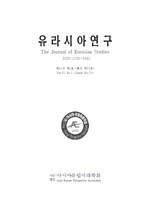- 영문명
- A Study on the Tang Shi’s Art of Poem Creation
- 발행기관
- 아시아.유럽미래학회
- 저자명
- 李文軍(Wen-Jun Lee)
- 간행물 정보
- 『유라시아연구』제8권 제2호, 151~169쪽, 전체 19쪽
- 주제분류
- 사회과학 > 사회과학일반
- 파일형태
- 발행일자
- 2011.06.30
5,080원
구매일시로부터 72시간 이내에 다운로드 가능합니다.
이 학술논문 정보는 (주)교보문고와 각 발행기관 사이에 저작물 이용 계약이 체결된 것으로, 교보문고를 통해 제공되고 있습니다.

국문 초록
唐湜 시가의 예술 표현 스타일은 「한 줄기 깊은 강과 한 편의 가볍게 날리는 잎」이라고 설명할 수 있는데, 바로 현실주의, 상징주의와 낭만주의의 특장을 융합한 것이다. 구체적인 이미지 표현방식은 함축, 깊음, 품위와 동시에 경이, 소탈, 우아함 등으로 표현된다. 唐湜 시가의 예술 표현 수단은 중국 고전시가의 영향을 받아 韻律美, 辭採美가 나타나 있고, 또한 서양의 고전 14行 시가의 影响을 받아 음률의 아름다움과 시경의 아름다움을 동시에 추구했다. 서양 현대주의 시가의 몇몇 기교를 응용하여「희극성」이라는 수단으로 운용했다. 唐湜 시가의 미학 예술특징 중 서양 시가 예술의 융합으로 다양한 성격의 경향이 나타난다.
따라서, 唐湜 시가의 역사배경과 현재 中西 시가 문학의 시스템을 역동적으로 관련시킨 부분을 다음 몇 가지 특징으로 설명할 수 있다. 첫째, 서로 다른 시가 주류 담론을 밝혀 唐湜 시가의 계원 예술을 표현하였고, 현대 시가의 기본개념을 기반으로 한 생각을 특수한 역사적 배경과 문화적 맥락으로 연결시켰으며, 그 특성과 시대적인 다양성을 포티 구조에 초점을 맞춘 아주 특이한 경향을 보여준다. 둘째, 唐湜의 시가 스타일은 현대문학 이론에서 “전통”과 “현대” 문학구조를 통한 구체적인 표현을 전개하여, 唐湜 시가 및 밝히지 못한 고대와 현대시의 문학 구조시스템을 활용하여 현대화와 그 시성의 특성을 융합예술로 승화하였다. 셋째, 미학 측면의 형태로 이미지 이론, 순수이론 및 융합형 이론의 하나로 현대 중국의 포티스의 독특한 가치를 부여하여, 唐湜의 문학사상은 융합적인 시가로 나타난다. 넷째, 唐湜 시가 구조 기반은 사회적 현실 사이의 관계에서 나타나며, 서양이나 중국의 전통적인 시가와 포티스를 처리하여 둘 사이의 모순을 한 시적 예술 감정으로 균형 있게 표현하였다. 다섯째, 唐湜 시가의 배경은 현대화의 복잡하고 고통스러운 예술실천 과정에서 현대 중국 시가의 비평이론 경험과 교훈을 담아 표현하였다. 따라서 현대 중국 시가에서 唐湜의 시가는 비판적이나 깨달음의 문학 경지를 지니고 있고 매우 유용하고 가치 있는 융합예술을 제공한다. 唐湜 포괄적인 연구뿐만 아니라, 실질적인 연구 결과는 부족하지만, 학문적 가치는 매우 높다.
영문 초록
Tang Shi's poetry describes with such beauty the integration of Chinese and Western poetry and individual pursuit. The poet has been respected with his personal styles for a long time. Tang Shi said: “The poet is the highest ideal of law, regardless of who he is, the totally consistent and complete sublimation of life experiences for literary experience, no waste, only the pure truth.” (Tang Shi: “Cindy ” contained “poetry to create” 1948) This is a “fusion” of the boundaries of subject and object devoid of a “Transformation.” Here, Tang Shi regarded the “fusion” state as the highest ideal of the poet, among his 1,111 kinds of basic poetic ideas. “Fusion” exists in a relationship, an artistic relationship between the various components of the interaction between networks. Tang Shi's poetic images in the discussion are related to the “relationship.” From the relationship between image and poetic image, the “image” is of course not the decorations. The poetic image is not a shape, but it should be a sense of inner spirit and integration. “From the relationship between the poet and the objective view of the world,” the image is the presence of the poet's real consideration of the objective world; on the other hand, the objective world is gathered in the poet's mind. The relationship between the objective view of the world and the poet image forms the structure of human spirit. “Image is produced from the most sober of mind and the most pious soul which interact together (Tang Shi: “On the image” contained in “Spring” 1948 No. 1). Between the poet and the objective view of the world, all the relationships are connected, and the “integration” state indicates a “relationship” of aesthetic state.
In his poetry and poetic practice as well as the poetic ideas of “fusion,” Tang Shi said that he “would like to try to fuse Chinese Classical and Modern Poetry with foreign poetry systematically.” (“New degree of set” in the “My Poetic Art.”) Tang Shi's attempt was very successful. His fusion of Chinese and foreign Poetics was commented by Mr Qian's praise, while he formed his own fusion style of Chinese and Western criticism. Tang Shi also “integrated” the implementation of poetic ideas in his own practice of poetry, and strived to integrate them with modern style.
Tang Shi's poem has classical beauty and modern Chinese cultural characteristics: beautiful words, delicate emotions, moving stories, uplifting warm, rich imagination, and so on. Also it has a modern Western characterization of the United States: a sonnet form, dramatic means, charming Italian deep thoughts, and so on. Through the perfect fusion of Chinese and Western art of poetry, his poem constitutes Qing Tang's aesthetic features. It is also a manifestation of his poetic personality.
목차
Ⅰ. 前 言
Ⅱ. 一条深沉的河与一片轻扬的叶: 唐湜诗歌总体风格
Ⅲ. 格律的古典美与新诗的戏剧化:唐湜诗的表现手段
Ⅳ. 中西诗艺的融合与个性化倾向—一唐提诗的美学特征
Ⅴ. 结 语
参考文献
키워드
해당간행물 수록 논문
- 성서적 생태학의 관점에서 러시아 에너지 기업의 CSR 반성
- 唐湜诗歌创作艺术综论
- 새마을금고 재무적 특성의 부실예측에 관한 연구
- 환경적 요인에 의한 대학생의 학교생활 만족도와 학업성취에 관한 연구
- EU의 개정통상정책과 대응방안
- 한국 국민연금기금의 영국 FTSE 투자에 따른 위험 관리를 위한 KOSPI 200 선물의 교차헤지에 관한 연구
- Future Possibility of Military Cooperation between Chinese People’s Liberation Army and Japanese Self-Defence Force
- 방산물자 가격경쟁력 향상을 위한 원가 및 계약제도 개선 연구
- 自立して用いられる日本語の助動詞に関する分析
- 宗教信仰与其教育功能的关系
참고문헌
관련논문
사회과학 > 사회과학일반분야 BEST
- AI와 디지털 문화 산업의 결합에서 저작권 및 윤리적 규범 준수의 필요성 연구
- 종합병원 간호사의 환자안전문화인식과 조직의사소통만족이 안전간호활동에 미치는 영향
- 인공지능(AI)과 윤리
사회과학 > 사회과학일반분야 NEW
더보기최근 이용한 논문
교보eBook 첫 방문을 환영 합니다!

신규가입 혜택 지급이 완료 되었습니다.
바로 사용 가능한 교보e캐시 1,000원 (유효기간 7일)
지금 바로 교보eBook의 다양한 콘텐츠를 이용해 보세요!



